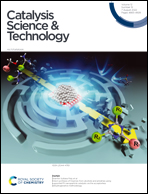Modification of CrCeOx with Mo: improved SO2 resistance and N2 selectivity for NH3-SCR at medium–low temperatures†
Abstract
NH3-SCR at medium and low temperatures is an effective method for the removal of nitrogen oxides (NOx) in industrial furnaces. Chromium (Cr) and cerium (Ce) based catalysts exhibit excellent NH3-SCR potential at medium and low temperatures, but their sulfur resistance and N2 selectivity need to be further improved. In this manuscript, the Mo(0.3)–CrCeOx catalyst was synthesized via the citric acid method, and showed high catalytic activity with excellent sulfur resistance and N2 selectivity. The mechanism of Mo doping was investigated. The highly dispersed amorphous MoO3 was found, forming a Mo–O–Ce structure and generating more strong acid sites. The mechanism of Mo doping for enhanced SO2 resistance and N2 selectivity was further investigated by in situ DRIFTS. By effectively modulating the catalyst basicity, the generation of the active intermediate cis-N2O22− species was promoted. The change from the E–R to L–H mechanism is the key. The strong oxidation of Cr6+ species was appropriately suppressed, thus the N2 selectivity was improved. It also prevents SO2 from competing for basic sites on Cr species. In a word, all the improved performances were attributed to Mo doping. Finally, the SCR process is proposed.



 Please wait while we load your content...
Please wait while we load your content...